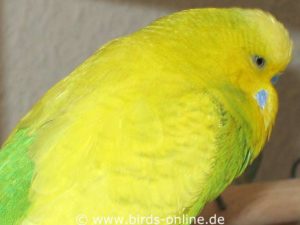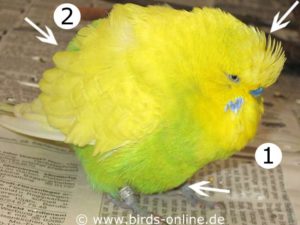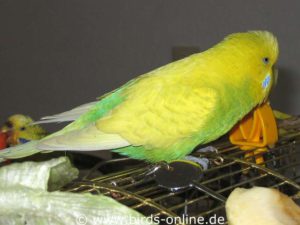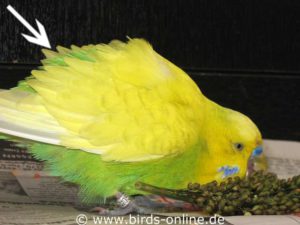- >>
- Birds Online – English
- >>
- Health and diseases
- >>
- General health topics
- >>
- Signs of illness
- >>
- Recognize a sick bird
Recognize a sick bird
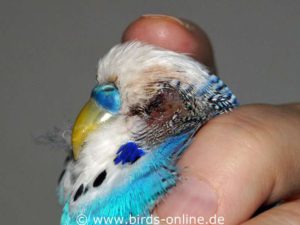
If a bird is injured, it’s easy to see in most cases. A bleeding wound is usually apparent. Even if a bird suddenly can no longer walk without limping, or if the animal can no longer fly, the assumption is obvious that the bird has suffered an injury and is thus ill. It’s just as easy to recognize a bird who suffers from a severe plumage disorder, who vomits, who has severe diarrhea, or who can hardly breathe. To overlook such conspicuous symptoms is nearly impossible.
But things are not always that simple. With a whole series of illnesses, however, birds show no such obvious symptoms – at least in the initial phase. Instead, the owner must pay attention to very inconspicuous signs to become aware of a (beginning) health issue.
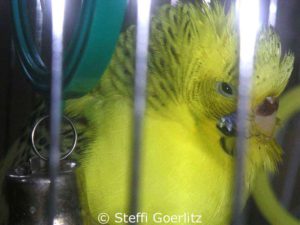
Nobody knows an animal as well as the bird owner. If you notice a difference in your bird’s habitual behavior or posture, this could indicate a gradual or beginning deterioration in its health. However, if a bird is not tame, it is often not so easy to tell whether she or he is sick or not. This is especially the case if the disease is still in its early stages. They should observe the animal therefore as carefully as possible because birds often overact their ailing health. In particular, budgies are perfect actors.
But keep in mind that many birds feel uncomfortable when they are intensively watched. In many predators, the eyes are next to each other in front of the head, which corresponds to the eye position in humans. Numerous birds therefore instinctively fear to be looked at by a being with eyes arranged like this. It is less frightening for birds if you look at them indirectly. Turn your head a little to the side and look at the birds only from the corner of the eye. In this way, you can look at your feathered friends without scaring them.
But what should you pay attention to in order to detect diseases? This article informs you about some important details.
Never show any weakness!
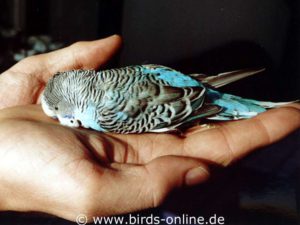
If a budgie or any other bird is suffering from a beginning illness or a general weakening, the animal will try to hide its deteriorating condition as long as possible by perfect acting. This behavior is innate to birds and is dictated to them by their survival instincts. In the wild, predators like birds of pray mainly concentrate on the weak and sick individuals of a flock or a group. Therefore, it is of utmost importance for a sick bird to behave as inconspicuously as possible and not to show any weakness.
Pet birds also outstandingly master this performing. The instinct of their wild ancestors is still alive, although pet birds live in captivity and don’t know the dangers of nature. Therefore, one often recognizes an illness just when it’s almost too late to help the animal. So always be alert and do not take anything lightly. The sooner you act in case of a disease of your bird, the better are the chances of healing and survival!
How strange, my never does that usually …
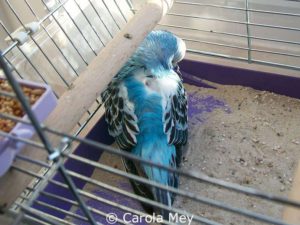
Once you have this idea, you should be on high alert. If a budgie, for example, suddenly does not sleep standing on one leg at night, this could indicate the beginning of an illness. Another example of the start of an illness is often a change in the amount of food and/or water consumed. If the bird drinks considerably more than usual, a kidney infection could be the cause. Or your bird eats more than normal, but for no apparent reason becomes steadily thinner. This is usually caused by a disease of the digestive system.
In mated birds, it’s particularly easy to notice when a usually very cuddly individual turns away from the partner quite often and wants to be left alone. If the animal is molting, this could be a more or less harmless reason for the changed behavior. Nevertheless, it is advisable to look at the bird very carefully. In many cases, physical discomfort expresses itself in an increased need for rest. You should be on high alert if a bird is no longer able to stay on a perch and crouches in a corner on the cage floor, see photo close to this paragraph. A bird who suddenly shows such behavior is probably seriously ill.
Changed sleeping habits
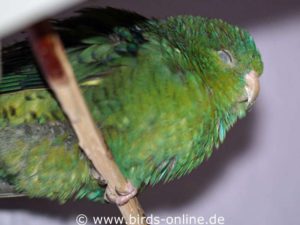
If your bird is usually bursting with energy, you should be seriously worried in case the animal suddenly sleeps more than average for a reason not apparent to you. A bird who frequently sleeps during the day either may suffer from a so-far undiscovered disease. Or the animal hardly finds rest at night. This may for example be because the cage is infested with blood-sucking mites or has been placed in a much too restless place. On the basis of the distribution of the droppings on the cage floor, you can recognize nocturnal sleep disturbances for example due to a possible mite infestation. However, not each bird who sleeps poorly at night is actually sick.
In addition, older birds – thus for example budgies who more than twelve years old – need to sleep more than their younger fellows. However, regarding these old-aged birds, it should also be paid attention to whether they suddenly sleep even more than usual. This could be an important alarm signal.
If your bird suddenly behaves extremely tame
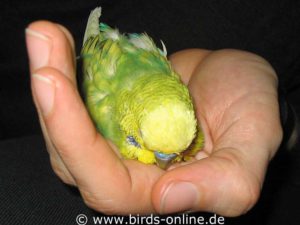
An unusual trustfulness as for example increased cuddling or even sleeping in the hand of the owner and/or very frequent cuddling with a caregiver can also be an early sign of a possible illness. If a bird who has never made bad experiences with humans feels uncomfortable because of an illness, she or he may seek physical contact. In this way, the weakened animal receives protection and warmth. Although as a bird owner one tends to regard such sudden signs of trust as touching and cute, one should definitely question them and watch the bird very carefully. Under certain circumstances, this could save the animal’s life, if a disease is discovered in its early stage.
What a puffball!
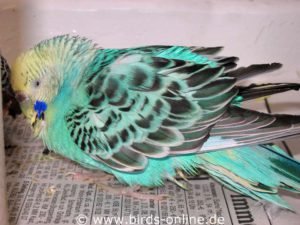
If a bird permanently fluffs up its feathers and appears round as a ball all day long without chirping or showing interest in its surroundings, there is likely a disease behind it. It can be just beginning or even chronic. A weakened bird without shining eyes, whose plumage is extremely puffed up and who doesn’t want to join the flock or partner, most probably feels so ill that the animal can no longer cover up its infirmity. It is a matter of utmost urgency, a visit to the avian vet should not be postponed for just a single hour! In such a state, the bird’s life is probably already threatened by the disease and it would be negligent to wait any longer.
Abnormalities in posture
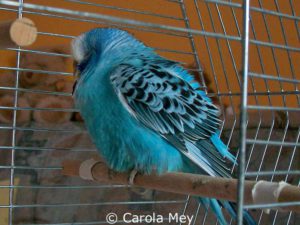
As for budgies as well as other pet birds, it is very helpful to look at the plumage and posture to be able to conclude the health condition. However, for this, it is necessary to have a trained eye and to know your birds and their individual habits in detail.
If a bird fluffs up its plumage strongly due to physical discomfort, certain characteristics show up in its silhouette. If you look at your bird closely, you will notice some bulges and edges in typical places. In contrast, the silhouette of healthy budgies is usually smooth, round, and harmonious. The following two photos of the same bird illustrate these differences:
One of the photos above this paragraph has some tags that indicate those parts of the body that should be paid more attention to. The silhouette of the bird does not appear harmonious and it has edges in several places. There, the feathers are extremely erect, so that gaps have formed in the plumage. This can be seen clearly by looking at the bird’s head. It is somehow low (see upright head position in the first photo). These characteristics are typical of physical discomfort.
The wings protrude edged from the silhouette, see the arrow marking. At the belly, the plumage also forms a hump. The curvature is even more pronounced near the crop (1). But also at that place, where the yellow neck feathers border on the green feathers of the back (2), an edge is to be seen in the bird’s silhouette.
The two images below show the same bird from a different perspective. In the first one, the budgie is healthy, in the second one the bird suffers from a starting disease. Pay close attention to the posture of the plumage on the back, which is marked with an arrow:
Cold and shivering
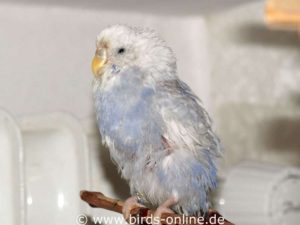
The body temperature of sick birds is often too low (hypothermia). So the animals tremble at the entire body what is to be recognized easily by the fluffed up plumage that is shaking. Whether an animal is freezing can also be determined easily in a tame bird by checking the temperature of the feet. If the animal has conspicuously cold feet over a long time and appears exhausted, it is very likely to be sick.
Depending on what a bird is suffering from, it may be breathing heavily and the tail is bobbing up and down visibly with each breath. If you observe this in your bird, a (beginning) infection of the respiratory tract could be the cause of the symptoms. But also birds who suffer from pain or whose digestive system is affected by a disease sometimes show this strained breathing. Besides, heavy breathing can occur if there is a swelling or a tumor inside the bird’s body, leaving too little space for the respiratory organs.
See your avian vet as soon as possible
If you have noticed that your bird is obviously not well, you should separate her or him from other birds as soon as possible, place the animal in a hospital cage and take your feathered friend to an avian vet immediately. Whatever your bird may be suffering from, only your vet will be able to give a reliable diagnosis based on an examination of the animal and your description of its behavior. Do not delay the visit of your vet unnecessarily, because most diseases have the greatest chance of cure in the early stages. Please do not make the mistake of asking on internet forums or in social networks what you should do now. An immediate consultation of the vet is the best choice in most cases!

